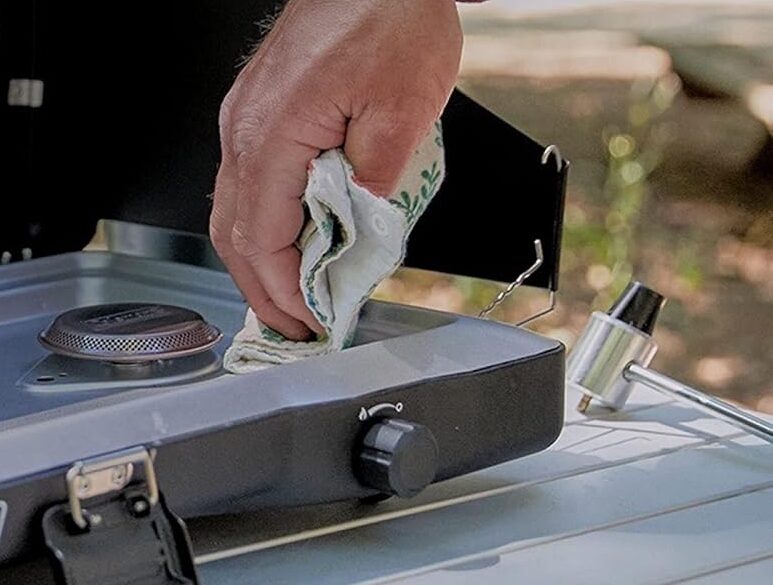How to Maintain and Clean Your Camping Stove
Introduction
A well-maintained camping stove ensures efficient cooking, fuel efficiency, and longevity on your outdoor adventures. Whether you’re using a canister, liquid fuel, alcohol, or wood-burning stove, regular cleaning and maintenance prevent clogs, corrosion, and performance issues.
In this guide, we’ll walk you through how to maintain and clean your camping stove, covering different stove types and best practices to keep them in top condition. If you’re looking for a new stove, check out our Best Camping Stoves of 2025 for expert recommendations.
Why Regular Stove Maintenance is Important
- Prevents fuel clogs and ignition failures
- Improves fuel efficiency for longer cooking times
- Extends the lifespan of your stove
- Reduces carbon buildup and improves flame consistency
- Ensures safe operation and prevents malfunctions
🔹 Pro Tip: Clean your stove after every trip and deep clean it every few months for peak performance.
How to Clean a Camping Stove: Step-by-Step Guide
1. Gather Cleaning Supplies
Before you start, have these items ready:
- Soft-bristle brush or toothbrush
- Mild soap and warm water
- Lint-free cloth or paper towels
- Isopropyl alcohol (for deeper cleaning)
- Small needle or pin (for unclogging fuel jets)
🔹 Best for efficiency: Keeping a small cleaning kit in your gear ensures quick maintenance after every trip.
2. Cleaning a Canister Stove
Canister stoves are compact and easy to clean, but they require occasional maintenance to prevent clogged burners and leaks.
Steps:
- Detach the fuel canister and let the stove cool completely.
- Use a soft brush to remove dirt and food residue from the burner head.
- Wipe the stove body with a damp cloth to remove grime.
- Check the fuel connection for leaks or cracks in the O-ring.
- Clear clogged fuel jets with a needle if the flame is weak or sputtering.
🔹 Best for durability: Store canister stoves in a dry, dust-free area to prevent corrosion.
3. Cleaning a Liquid Fuel Stove (White Gas, Kerosene, or Multi-Fuel)
Liquid fuel stoves require more maintenance due to fuel buildup and moving parts.
Steps:
- Disassemble removable parts, including the fuel line and burner.
- Clean the fuel line with a needle or fuel filter tool to remove debris.
- Scrub the burner head with a brush to remove soot and carbon deposits.
- Rinse the pump and fuel bottle with warm soapy water.
- Dry completely before reassembly to prevent rust.
🔹 Best for performance: Pump the fuel bottle occasionally to keep seals lubricated and functioning smoothly.
4. Cleaning an Alcohol Stove
Alcohol stoves are simple, lightweight, and low-maintenance, but they can develop burn residue over time.
Steps:
- Wipe down the stove body with a damp cloth after each use.
- Use isopropyl alcohol to remove sticky fuel residue.
- Inspect for cracks or warping, especially on titanium or aluminum models.
- Avoid using abrasive cleaners that can degrade the metal.
🔹 Best for longevity: Store alcohol stoves in a dry place to prevent corrosion.
5. Cleaning a Wood-Burning Stove
Wood-burning stoves accumulate ash, soot, and tar that require regular cleaning to maintain airflow.
Steps:
- Empty all ash and debris after every use.
- Use a brush or scraper to remove soot from the burn chamber.
- Wipe down the exterior with a damp cloth.
- Check ventilation holes for blockages.
- Dry completely to prevent rust buildup.
🔹 Best for safety: Avoid storing a wood-burning stove while it’s damp or dirty—this can lead to corrosion.
How to Maintain Your Camping Stove for Long-Term Use
1. Store It Properly
- Keep it in a dry, ventilated space to prevent rust and corrosion.
- Use a storage bag to protect delicate components.
- Loosen fuel caps slightly to relieve pressure in stored fuel bottles.
2. Inspect Your Stove Regularly
- Check for loose parts or missing screws before each trip.
- Test the ignition system to ensure it lights easily.
- Examine O-rings and seals for cracks or wear.
- Replace fuel filters and pump seals every season.
🔹 Best for reliability: A quick pre-trip inspection prevents unexpected failures in the field.
3. Avoid Common Mistakes That Damage Your Stove
- Forgetting to clean the burner after use.
- Solution: Wipe it down after every trip to prevent buildup.
- Using dirty fuel in liquid fuel stoves.
- Solution: Always use high-quality, filtered fuel to avoid clogs.
- Packing a wet stove.
- Solution: Air dry completely before storing to prevent rust.
- Over-tightening fuel canisters.
- Solution: Hand-tighten only to prevent damage to the threads.
FAQs
How often should I clean my camping stove?
- Spot clean after every trip and deep clean every few months.
Can I use soap and water to clean my stove?
- Yes, but avoid harsh detergents that can damage metal components.
How do I fix a weak or sputtering flame?
- Clean the fuel jet with a needle and check the fuel supply.
What’s the best way to store a camping stove?
- Keep it in a dry place, inside a protective bag, and ensure it’s completely dry before storing.
Final Thoughts
A well-maintained camping stove ensures efficient performance, fuel savings, and long-lasting reliability. By cleaning it regularly, checking for wear, and storing it properly, your stove will be ready for every adventure.
Looking for the best camping stoves this year? Check out our Best Camping Stoves of 2025 for expert recommendations!
